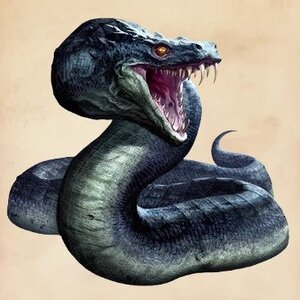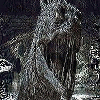
The Basilisk (Harry Potter)
CBUB Wins: 2
CBUB Losses: 5
CBUB Ties: 0
Win Percentage: 28.57%
Added by: TheForce
Read more about The Basilisk (Harry Potter) at: Wikipedia
Official Site: J.K. Rowling
Magical creatures comprise a colourful and integral aspect of the fictional wizarding world in the Harry Potter series by J. K. Rowling. Throughout the seven books of the series, Harry and his friends come across many of these creatures on their adventures, as well as in the Care of Magical Creatures class at Hogwarts. Rowling has also written Fantastic Beasts and Where to Find Them, a guide to the magical beasts found in the series. Many of these are derived from folklore, primarily Greek mythology, but also British and Scandinavian folklore. Many of the legends surrounding mythical creatures are also incorporated in the books. "Children ... know that I didn't invent unicorns, but I've had to explain frequently that I didn't actually invent hippogriff," Rowling told Stephen Fry in an interview for BBC Radio 4. "When I do use a creature that I know is a mythological entity, I like to find out as much as I can about it. I might not use it, but to make it as consistent as I feel is good for my plot."
Many pets in the series are ordinary animals with magical properties. Owl, for example, deliver mail. Only creatures that exist exclusively in the magical world are listed below.
Magizoology (a portmanteau of "magic" and "zoology") is the study of magical creatures in the Harry Potter series. A person who studies Magizoology is known as a magizoologist. There are magizoologists who work in the Ministry of Magic, particularly in the Department for the Regulation and Control of Magical Creatures. One notable magizoologist is Newt Scamander, who in the universe of the series is the author of Fantastic Beasts and Where to Find Them, a textbook on magical creatures that is popular in the wizarding world.
The Department for the Regulation and Control of Magical Creatures of the Ministry of Magic is responsible for overseeing and regulating magical creatures. It is divided into three divisions: the Beast Division, the Being Division, and the Spirit Division. A "being" is generally defined, according to Fantastic Beasts, as "any creature that has sufficient intelligence to understand the laws of the magical community and to bear part of the responsibility in shaping those laws." This includes humans, , hags, and vampires. According to this definition, fairies, pixie, gnome, and most other creatures are classified as "beasts." and merpeople are said to have rejected "being" status in favour of "beast" status, as have leprechaun. and Animagi are notable because they are typically in human form—a werewolf transforms from human state only at the full moon, and an Animagus is a human who has learned to transform into an animal at will. Their classification is unclear, and offices responsible for werewolves exist in both the Beast and Being Divisions. A number of creatures, such as , , banshee, veela, dwarf, and , have never been described in the novels either as beings or as beasts, so their legal status is unclear. Affairs related to come under the auspices of the Spirit Division.
Images with a green border may be set as the character's main profile image (For images 200x200 or 300x300 pixels square).
CBUB Match Record:
| Result | Opponent | My Score | Their Score | |
|---|---|---|---|---|
| Loss | The Xenomorphs | 22 | to | 55 |
| Loss | The Xenomorphs | 32 | to | 69 |
| Win | The Cyclops (The 7th Voyage of Sinbad) | 48 | to | 38 |
| Loss | He-Man (Masters of the Universe) | 20 | to | 76 |
| Loss | Trogdor | 24 | to | 44 |
| Loss | Luke Skywalker | 5 | to | 30 |
| Win | Reptile (Mortal Kombat) | 9 | to | 5 |
No Fantasy Draft Records Available





